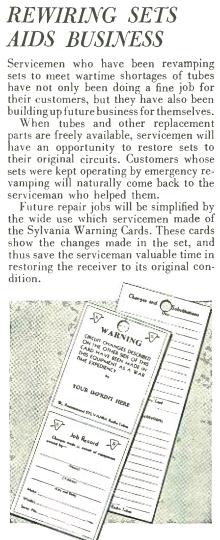I’ve always been aware that civilian radio sets were not manufactured during World War 2, but I never knew the details. Those details are reported on page 22 of Broadcasting, March 16, 1942.
On March 7, 1942, the War Production Board, which had itself been created by executive order on January 16, 1942, issued its order regarding radio equipment. Under that order, all manufacture of civilian receiving sets was to cease on April 22 in preparation for the conversion of the 55 manufacturers to war production. Sets in production as of that date were allowed to be finished, but only if not more than $500 in materials (not including wooden cabinets) were used.
30,000 were employed by these firms, and they had collectively produced more than 13 million sets prior to the order. They had done $240,000,000 in business during 1941, and all of their resources were now to be turned to war production.
War orders for all of the companies were already in place, and they were to begin gearing up for war production as soon as the manufacture of civilian sets ended.
The War Production Board estimated that the firms would turn out about three million more sets before the deadline, which would increase the total number of civilian sets to about 60 million.
Those sets would need to be kept in good shape, since the Board doubted that even replacement parts would be manufactured for the duration of the war. The Board even hinted that rationing and registration might be required, noting that some homes had more than one good set, and extras could be used in homes having none. But the Board’s chairman believed that the current supply of sets, along with those in production and on retailer’s shelves, would be sufficient for the nation’s needs.
The next month, Hugo Gernsback, editor of Radio Craft magazine, opined in an editorial as to the possibilities this situation presented for America’s youth: “Young men between the ages of 12 and 17 who are not subject to the draft have time on their hands, which they now can turn into cash by building sets not only for their friends and relatives–yes, but even sell them to radio stores. It is certain that if a number of boys gang together and manufacture a few sets every week in their spare time, and providing the sets are made right, they can be sold to the trade.”
Gernsback noted that millions of obsolete sets cluttering up storerooms would be a source of parts, as would automobile junk yards and junk shops, since they were loaded with a goldmine of parts. He pointed out that readers could “perform a patriotic service to conserve whatever substitute materials we have and turn such materials into radio sets.”
 Early in the war, manufactured parts were hard to come by. By the end of the war, some common parts were becoming available for civilians, but most were in limited supply, and most could be sold only to those attesting that they would be used to make repairs to existing sets. But throughout the war, radio service men had to be creative due to the absence of needed parts. The February 1945 issue of Radio News reported that, barring a miracle, civilian production would not resume until victory over Japan. That issue also contained an ad by Sylvania, a portion of which is shown here. When a service man had to make an emergency repair by re-wiring the set to make use of available parts, he could document the change on the card in order to facilitate restoring the set to its original condition when parts became available after the war.
Early in the war, manufactured parts were hard to come by. By the end of the war, some common parts were becoming available for civilians, but most were in limited supply, and most could be sold only to those attesting that they would be used to make repairs to existing sets. But throughout the war, radio service men had to be creative due to the absence of needed parts. The February 1945 issue of Radio News reported that, barring a miracle, civilian production would not resume until victory over Japan. That issue also contained an ad by Sylvania, a portion of which is shown here. When a service man had to make an emergency repair by re-wiring the set to make use of available parts, he could document the change on the card in order to facilitate restoring the set to its original condition when parts became available after the war.
Click Here For Today’s Ripley’s Believe It Or Not Cartoon
![]()


Pingback: Walgreen’s Aetna Midget Radio, 1940 | OneTubeRadio.com
Pingback: Crosley Looks Forward to Postwar Radio | OneTubeRadio.com
Pingback: Radio Keeps a Government Girl Company, 1943 | OneTubeRadio.com
Pingback: 1945 Car Radio Conversion | OneTubeRadio.com
Pingback: 1941 Model RCA Victor Radios | OneTubeRadio.com
Pingback: 1942 Farm Sets for Emergency Use | OneTubeRadio.com
Pingback: End of Wartime Civilian Radio Production | OneTubeRadio.com
Pingback: Preparing for the End of Civilian Radio Production | OneTubeRadio.com
Pingback: 75th Anniversary of End of Civilian Radio Production | OneTubeRadio.com
Pingback: 1944 Toy Phonographs | OneTubeRadio.com
Pingback: Wartime Diversification for Radio Dealers | OneTubeRadio.com